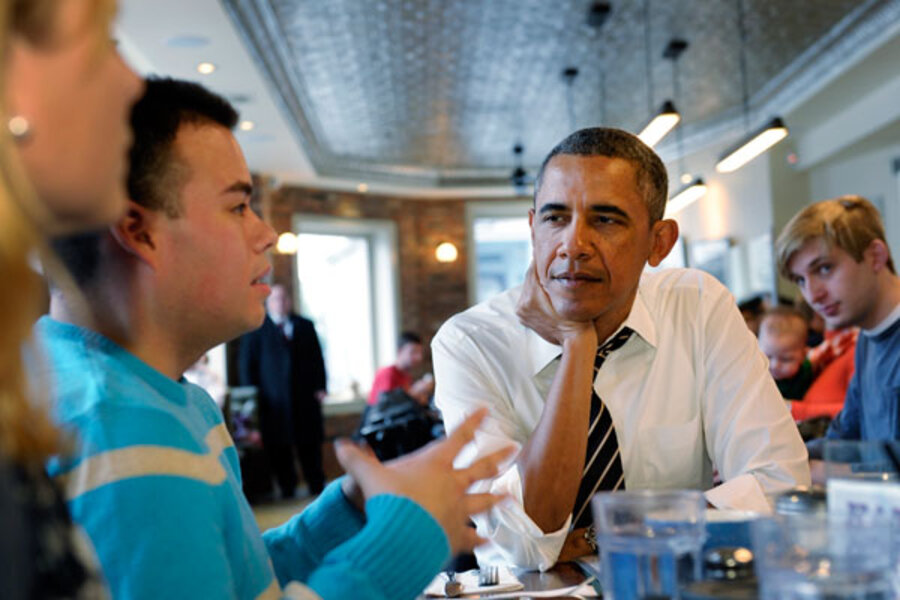Obamacare youth enrollment lower than expected. Why the optimism?
Loading...
| Washington
Young American adults are enrolling in health insurance in lower-than-expected numbers on the government-run marketplaces, according to numbers released Monday by the Obama administration.
At the half-way point of the October-to-March enrollment period for the Affordable Care Act (ACA), only 24 percent who have selected a plan are between the ages of 18 and 34. That’s well below the 38.5 percent forecast for that age group by the administration last September.
But both administration officials and private analysts said those current enrollment levels are not cause for alarm, partly because young Americans were always expected to be among the last to sign up.
Getting enough young, healthy people to enroll in the individual health-insurance market is critical to the success of the ACA, a.k.a. Obamacare. Their premiums help to pay for the care of older, less healthy Americans. The rule of thumb is to enroll each age group in rough proportion to its representation in the population as a whole. For the 18-to-34 cohort, that’s one-third.
Officials from the Department of Health and Human Services (HHS) expressed confidence that young-adult enrollment would pick up, in line with the experience of Massachusetts’ 2006 health reform.
“Many of them may have applied and not chosen a plan because they want to think about it, they want to shop around, they haven't been insured before,” said Gary Cohen, director of the Center for Consumer Information and Insurance Oversight at the Department of Health an Human Services' Centers for Medicare and Medicaid Services, told reporters in conference call Monday.
“So we're actually very pleased with the percentage that we have so far, and we expect that percentage to increase,” Mr. Cohen added.
Monday’s numbers were the first since the start of ACA open enrollment to reveal demographic data, though they did not include information on the health status of enrollees – which is more important than age. That will be harder to track, since the enrollment form does not ask about medical conditions.
In all, nearly 2.2 million Americans selected plans from the state and federal marketplaces between Oct. 1 and Dec. 28, 2013. Of those, nearly 1.8 million signed up in December, representing a five-fold increase from the October-to-November period, in which HealthCare.gov and some state exchanges experienced major failures.
Young enrollees – the 18-to-34 cohort – saw the largest spike in enrollment at HealthCare.gov in December, with an eight-fold increase.
“These enrollment figures are encouraging for this stage in the process, especially with all the early systems problems they experienced,” says Larry Levitt, a senior vice president at the Kaiser Family Foundation. “We’re at halftime in the open enrollment period, and I would expect larger numbers of young people to enroll in the second half between now and March.”
Mr. Levitt also points out that what really matters is insurers’ assumptions when they set premiums for 2014.
“We don’t know for sure, but my assumption is that insurers assumed that enrollment would be skewed somewhat towards older individuals,” he says.
Even if the current mix of enrollees holds, Levitt does not foresee a shock to the insurance system, with only a potential 2 to 3 percent increase in premiums in 2015. “I see no signs at this point of a feared premium ‘death spiral,’ ” in which premiums skyrocket and the system collapses, he says.
Other experts on health reform said the administration seemed to have landed on its feet after the disastrous rollout of HealthCare.gov.
“Overall enrollment of 2.2 million is I think pretty good after two months of bad implementation,” said Caroline Pearson, a vice president for health reform at the consulting firm Avalere Health.
On the age issue, she says, 24 percent of enrollees under 35 is not where the system needs to be ultimately, but it’s not cause for alarm.
“We always assumed the older, sicker people would enroll first,” Ms. Pearson says. “I look at this as a worst-case mix in terms of age, but it won’t cause losses.”
The first hint of how insurers are doing under the reform may come in calls to their investors. “That’s the first I expect to hear them say they’re looking at a higher spend or lower spend than we anticipated,” says Pearson.
After that, the next clue will come during the risk mitigation process provided for in the ACA. “Reinsurance” money, which is funded by a tax on every health plan, will help insurers pay for expensive claims. Under the system known as “risk corridors,” insurers that take in more in premiums than they end up needing will give some of the excess to the government. If the premiums are too low, the government will help cover some of the losses.








